Tables of contents
1. Introduction
It describes the train parameters used in PCS. It will not describe how to copy them or what validation messages are displayed in the system for missing or incorrectly entered values.
2. Located
The train parameters step is the 4th step in the creation flow.
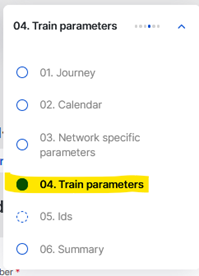
The train parameters are the common parameters that can be set for a section, i.e. between two locations. The sections of the path requests are shown on the left side, grouped by territories.
In the below example, Prorail territory has 3 locations:
- Maasvlakte
- Kijhoek Noord
- Betuweroute Meteren
- Zevanaar grens
It means 3 sections between the 4 locations.
- Maasvlakte – Kijhoek Noord
- Kijhoek Noord – Betuweroute meteren
- Betuweroute meteren – Zevanaar grens
Multiple path requests in the territory are shown in separate sections.
3. Switch territory
Always the first territory is shown first on the sidebar. Use the arrows back and forward to switch between the territories on the top:
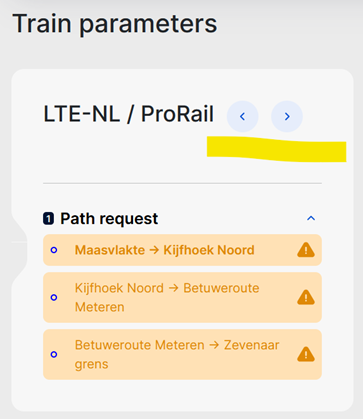
4. Status of the parameters
The status of the parameters is shown on the left side of the sections.
- If none of the parameters are filled, the “dot” marking is indicated on the sections highlighted with yellow that there are mandatory train parameters that you need to enter.
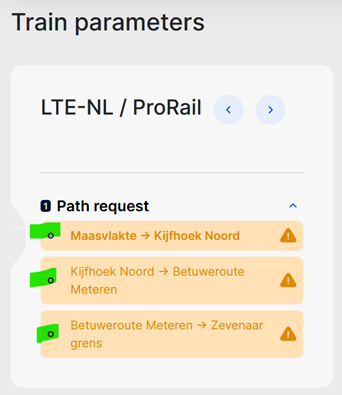
- The “dot “ indicates that some parameters have already been added without the yellow backround

- Sections with the connected bar have the same parameters. Clicking on the bar allows the user to edit the relevant parameters together.

5. Type of train parameters
The associated train parameter fields are grouped together:
- Traction details
- Train dimensions
- Speed
- Breaking
- Train characteristics
- Train control
- Dangerous goods
- Combined traffic profile
5.1 Traction details
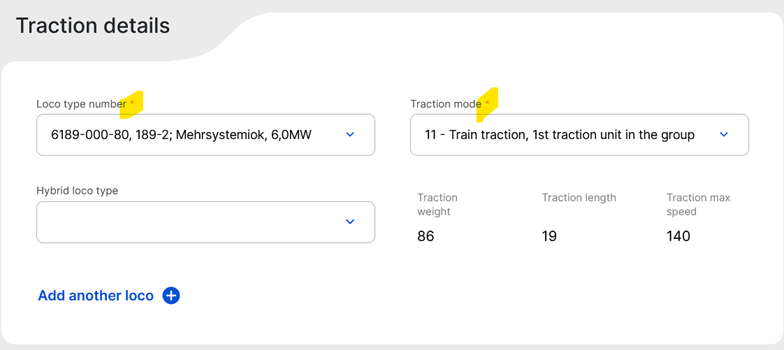
- Loco type number: Mandatory to fill. The loco type number is the combination of series number, serial number and country code. Example of loco type: 6186-003-80. The country code 80 is for Germany, and this loco should be used in Germany. Loco types are shown in the drop-down with the national ID and explanation. By placing the mouse cursor on the drop-down user can scroll through the available locos:
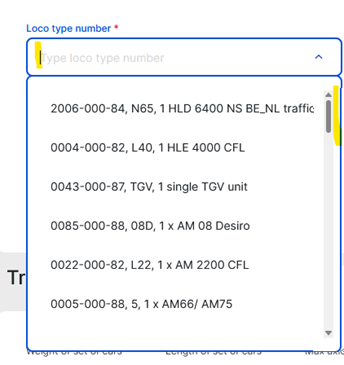
- Traction mode: Mandatory to fill. The same codes are available for all loco types. Identifies the mode of deployment of traction within a train. First digit – traction role, second digit – position in the group of traction units with the same role.

- Hybrid loco type: The type of traction (power unit) to be used in train operation.
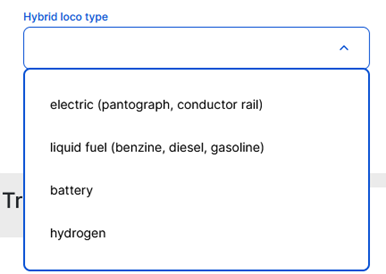
- Traction weight, Traction length: the Weight(t)/length(m) of the traction unit. When the user selects the desired loco, the traction values are displayed automatically. This data is defined by the IMs once the loco is registered in the system.
- +Add another loco: Adds a new set of fields to add another loco if it is needed. If there are a minimum of two locos the delete option is enabled. If there is only one loco, it cannot be deleted.
5.1.1 Search for loco
The easiest solution is to search for locos in the following ways:
Series number: the search condition is set to “starts with”, users should start typing in the required series number:
National ID or explanation. The search condition is set to “contains” if users can search by typing the letters that are contained in them. Example test loco:
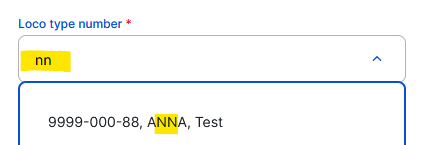
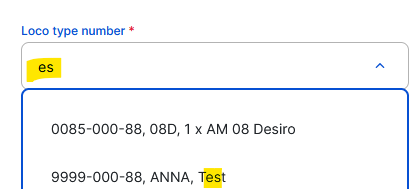
5.2 Train dimensions
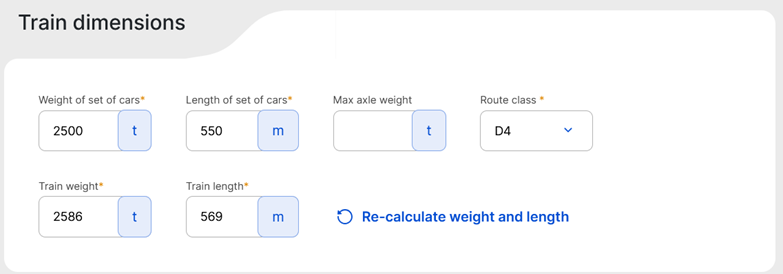
- Weight of set of cars: Mandatory to fill. The weight of the cars is set in tons It is an integer number format with a maximum of 5 digits (1-99999).
- Length of set of cars: Mandatory to fill. The length of the cars is set in meters. It is an integer number format with a maximum of 4 digits (1-9999).
- Train weight: Calculated from the weight of the loco (traction weight) and cars. Users can manually update this field. The value of the train weight must be equal to or greater than the value of the weight of set carriages. It is an integer number format with a maximum of 5-digit value 1-99999.
- Train length: Calculated from the length of the loco (traction length) and cars. Users can manually update this field. The value of the train lenght must be equal to or greater than the value of the lenght of set carriages.
- Max axle weight: the maximum allowed axle weight for a carriage within a train. Unit in tons per axle. Depending on national rules. It is a decimal number format with a maximum of 3-digits 0.1-99.9 (limited to a single decimal digit)
- Route class: it lists the available route classes
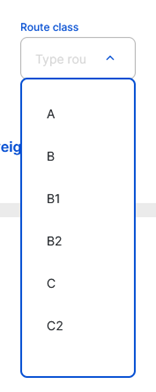
- Re-calculate: it calculates the train weight/length values with the traction weight/length. Users should use the recalculate button when manually editing these fields to get the fields calculated correctly. In the below example, the train weight/length was manually updated, and the correct values should be for the train weight 1084t and for the train length 519m.
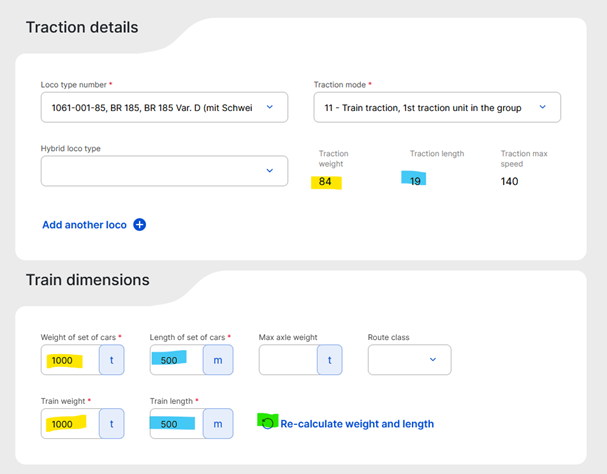
5.3 Speed

- Requested train max speed: Mandatory to fill, it is the requested max. speed of a train in km/h. It is a number field with a maximum of 3 digits (0-999). Only applicants can edit this field. The rest of the speed fields in the speed fields group can only be edited by the IMs in their phases, where they have editing rights.
- Maximum infrastructure speed: The IM can inform the applicant about the maximum allowed speed. If the field is defined by the IM the requested train max speed of the train entered by the applicants cannot exceed this limit. It is a number format with a maximum of 3 digits (0-999).
- Speed planned by IM: The IM can inform the applicant of the speed which was the basis for path construction. Used in case of preconstructed products published by RFCs. If the field is defined by the IM the requested train max speed of the train entered by the applicants cannot be lower than the planned speed. If the value is lower, a warning is shown. It is a number format with a maximum of 3 digits (0-999).
5.4 Braking
Coasting: IM indicates to the RU whether the driver can rely on coasting. The format of the field is a boolean, IM users should tick the checkbox to use the value.

- Brake type: it is an optional field, but it can be mandatory to fill in for some IMs. It lists the available break type values. Users can scroll in the list or start typing the letters of the break types in.
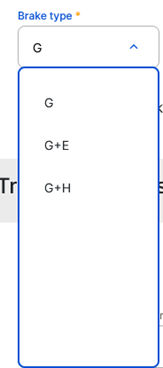
- Braking ratio: the minimum percentage of braking. It is an integer value with a maximum of 3 digits (1-999).
- Minimum braked weight percentage claimed by IM: the minimum percentage of braking by IM. It is an integer value with a maximum of 3 digits (1-999).
- Braking weight: it shows the braked mass of the carriage in tons according to the type of braking system. It is a number format with a maximum of 5 digits (0-99999).
- Emergency brake override: It is a boolean value. The ability of the whole train (all carriages and traction units) to override the emergency brake signal.
5.5 Train characteristics

- Push-pull train, Bogie wagons only, Tilting function: users should tick the checkbox to use any specific train characteristics.
- Operational train coupling strength: It is an integer value with a maximum of 4 digits (1-9999) in kN. The operational strength of the train coupling is a crucial technical characteristic for the determination of a freight train’s tonnage rating.
5.6 Train control

- Train radio system: it lists the available radio communications systems.
- Train control system: it lists the available types of train control systems according to the TAF/TAP TSI XSD. Users can scroll for more train control systems on the list.
5.7 Exceptional gauging indent
Should be filled if the transport exceeds the normal gauge. It indicates that one or several exceptional gauges are on the train or the carriages.

- IM partner: it is an IM code, which is a 4-character alphanumeric company code.
- Exceptional gauging code: it is the code for the exceptional gauge. It is a string value of a maximum of 1-24 in length.
5.8 Type of service
These train parameters are relevant for passenger traffic.

- Special service description code: it lists the code of the service (e.g., breakfast, dinner, child etc.)
- Facility type description code: it lists the code of the facility (e.g., bicycle transport, wheelchair access, family compartment)
- Traffic type: Information about the type of traffic (combined, rolling highway, EuroCity, and so on). A placeholder for coded values (e.g. from Merits). Min 1 max 2 characters long string.
- Characteristic description code: it lists the code of the characteristics (e.g.: first class, second class, no reservation etc.)
- Commercial traffic type: it lists the available values according to the TAF/TAP TSI XSD 3.4.0.0.
5.9 Dangerous goods

It is a freight-only parameter set. Selecting the value to “Yes” value then it shows a set of fields to fill for the dangerous goods. If any data is entered and then the Dangerous Goods option is changed to “No”, the users are warned of the possible data loss.
- Hazard identification number: it is a string value with a maximum of 2 to 4 characters in length.
- UN number: it is a string, with a 4-character length, pattern: \d*[1-9]\d*. The UNNumber of the dangerous goods according to the RID chapter 3.2, table A, column 1
- Packing group: I = High danger, II = Medium danger, III = Low danger
- Danger label: it is a string value with a maximum of 1-4 characters in length.
- RID class: The class of dangerous goods according to the RID chapter 3.2, table A, column 3a.
- Limited quantity: it is a boolean value. Indicator for labelled dangerous goods in limited quantity according to chapter 3.-4 RID.
- Dangerous goods weight: it is the weight of the dangerous goods in kilograms. It is a number format with a maximum of 5-digit values (0-99999).
- Dangerous goods volume: it is the volume of dangerous goods in cubic meters.
- +Add another dangerous goods: Users can add a new set of fields to add another set of dangerous goods parameters.

5.10 Combined traffic profile

It is a freight-only parameter set. Selecting the value to “Yes” value then it shows a set of fields to fill for the profile fields. IM users can define dependency levels between the IM network-specific parameters then profile values become mandatory. If any data is entered and then the Combined traffic profile option is changed to No, the user is warned of the possible data loss. One option refers to “P” (Semi-trailer/road semi-trailer), and the other option refers to “C” (Swap body). The profile fields are number values with a 3-digit maximum length (0-999).
- P1: requires the code in case the gauge of the semi-trailer is ≤ 2500 mm
- C1: requires the code in case the gauge of the swap body is ≤ 2550 mm
- P2: requires the code in case the gauge of the semi-trailer is > 2500 mm ≤ 2600 mm
- C2: requires the code in case the gauge of the swap body is > 2550 mm ≤ 2600 m


